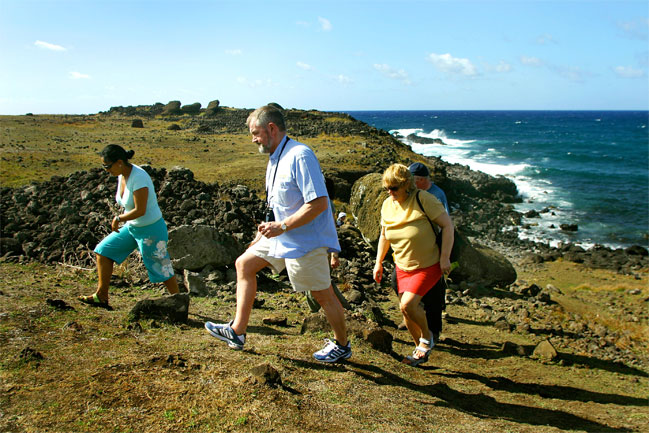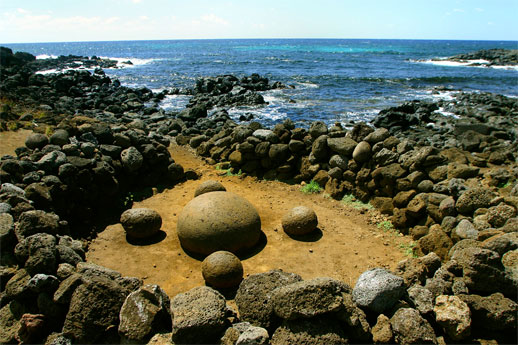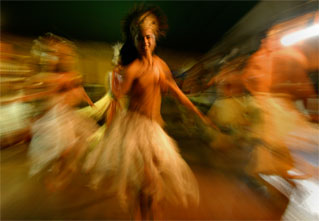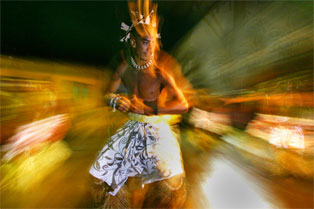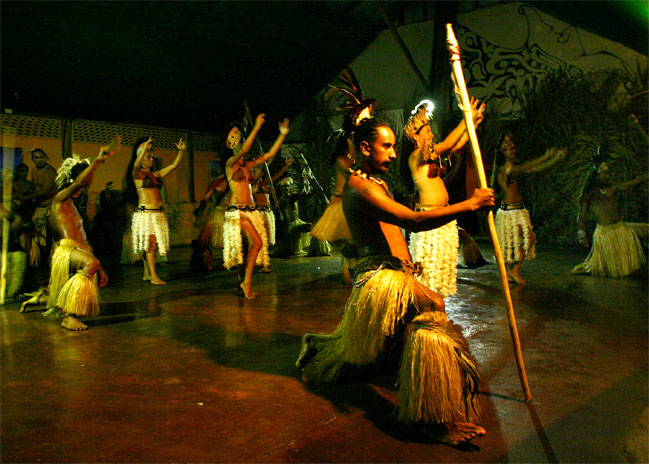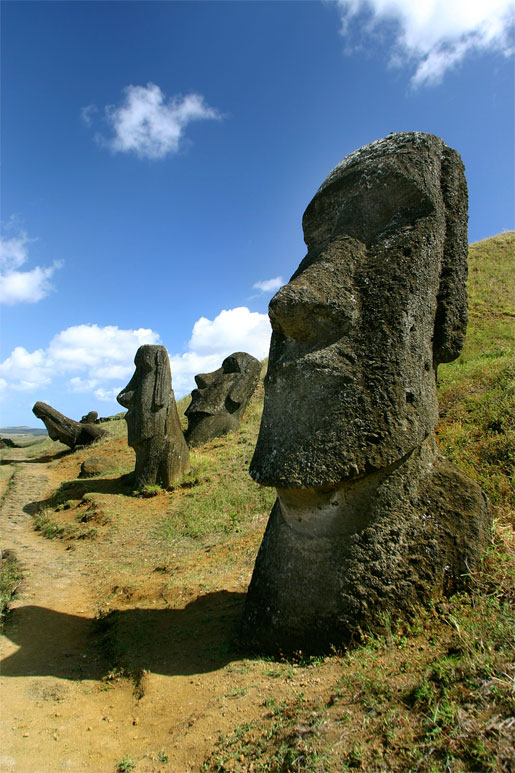
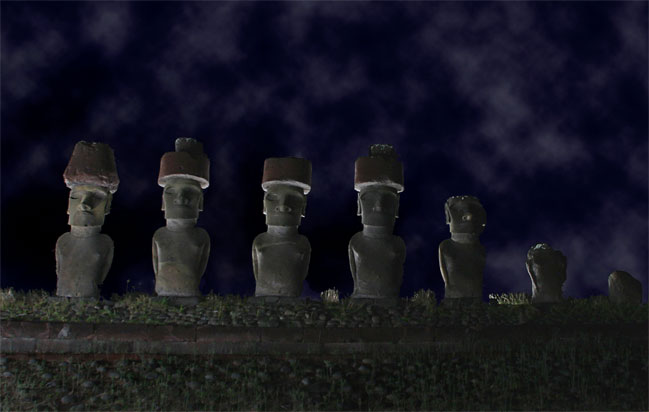

Most yachtsmen sail directly from Galapagos to the Marquesas islands in French Polynesia. We chose to set our course south-southwest towards Easter island, 2000 miles away from almost anything, including Chile, Galapagos and Tahiti. After 16 days at sea, with very good winds, a tough case of the flu and some electrical and mechanical problems, we could finally raise Easter Island in the horizon. It was about 03 p.m., and Rune was at the helm. At first, he could only see a dim shadow in the distance. On the way to Easter island by plane from Norway, was Runes parents, and together we were going to spend Easter, on, precisely, Easter Island. One of the more original places to arrange a family rendez-vous, one should think. And we managed to arrive just a couple of hours before they landed, even though they ordered their tickets while we were still in Panama, more than 3.000 miles and six weeks earlier. Timing, or just good luck? Well, let others decide!
One of the most prominent features with Easter Island, is the absence of a proper harbour. Two very narrow and shallow coves, cut into a stony and wild coastline is everything the locals have. As we arrived, we could see that the military supply vessel from Chile had arrived. That, and another, civilian freight vessel, arrive every three or four months. We were the only sailboat, and could use the buoy that has been put out there for us. And we were happy to use it, because during the three weeks or so, that we spent here, we had gales with swell up to 12-15 feet, pounding in straight from the high seas, completely unchallenged. We stitched our boat to the buoy with chains and thick rope. The foundation for the buoy is an old tractor sitting on the seabed, so we were very confident in the buoy, and rightfully so. According to the Chilean Navy, we are supposed to have one hand onboard at all times, to tend to the vessel. But many days, the weather was simply too rough for us to get out there, and Underveis had to spend more than one night all by herself. The sight of our anchor light, swinging several meters from side to side, and back and forth, while the swell came thundering in along the coast, making all conversation impossible, is unforgettable. We didn’t sleep well every night. But, as always, Underveis handled it, and didn’t seem to have any problems tackling the weather at all. We are constantly reminded of what a sturdy and good ship she is. More faithful travel companion can hardly be found.
# Easter island (in Polynesian Pito o te Henúa (The navel of the world) or Maa-ki-te-Rangi (Eyes facing the sky) is situated in the South-Eastern Pacific, some 3,515 Kilometers west of continental Chile, and 2,075 kilometers east of Pitcairn island, the nearest populated place. This makes Easter island one of the most desolate places on earth.
# Easter island is under Chilean rule, and is best known for its ancient stone statues, called Moai. Official language is Spanish, but many locals speak rapanui, a Polynesian tongue.
# Easter islands history is known from about 400 A.D. The first settlers called the island Te Pito O Te Henua (The navel of the world). They built an outstanding and complex civilization in the island, completely cut off from the outside world.
# The population is assumed to have reached a peak of some 10 – 15,000 inhabitants at some point, and due to the islands limited natural resources and isolated position, there were more people there than could be sustained. The population diminished, and at the same time, European explorers reached the island. These brought new and unfamiliar diseases that just contributed to Easter islands problems.
#Easter island is the only known human society to have extinct all of its forests, harvested and extinct all of its edible flora and fauna, even though they knew that they were alone in the world.
# The statues in the island stand up to 13 meters tall, and weigh up to 60-70 tons. The largest one was never finished, and would have been 22 meters tall and weighed 200 tons. They are called moai and are carved from stone out of the Rano Raraku volcano. Many theories exist about why the statues were made. The most predominant being that they were made in honor of the populations forefathers or important living persons.
# The main source of income is tourism and some fish export. The currency is Chilean pesos, but US dollars are also in use. There are several ATMs in the island, but none that accept VISA. Some restaurants and shops accept VISA and credit cards. 400 pesos is approximately 1 USD.
(Sources: Wikipedia)
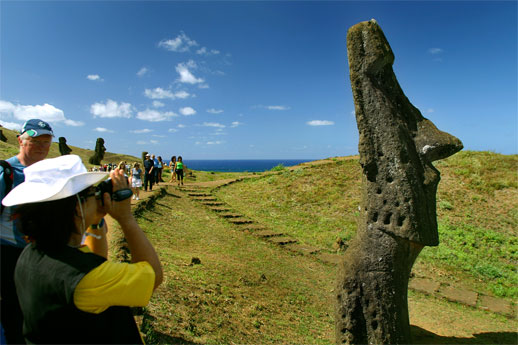

One day we had such good weather that we could take Underveis and go to the islands only beach, Anakena. We swam, barbecued and enjoyed ourselves drinking Cuba Libre until nightfall. Rune will never forget the sight of his very brave parents, in our shitty 2,40 meter dinghy, sporting a 3,5 hp Johnson outboard, as we took off back into shore at Hanga Roa from the buoy late in the evening. It was pitch black, and around us we could sense and hear more than see, the swell just a few meters away, as we aimed for the lighted windows in our favourite restaurant. Then, all of a sudden, we were safe behind the little breakwater. Braver parents than mine out there, anyone?
A few other sailboats came visiting during our stay, and altogether Easter Island is being visited by around 30 sailboats a year. Considering that e.g. Trinidad has approximately 2,700 visiting boats a year, we still consider Easter Island to be far off the beaten track, and that it is still relatively untouched for the yachting community. For Rune, who is not going home this summer, but will be solo sailing, it was a bit sad to see his parents off at the airport after a wonderful week together, knowing that he will not be seeing them again for a while. But, as always, the homesickness soon faded.
As we noticed both through the weather, the sea state and temperature, winter is approaching in the Southern hemisphere. April in Easter Island equals October in the Northern hemisphere. Both the tourist season and other activities on the island were thus coming to a seasonal end, something we really appreciated.
